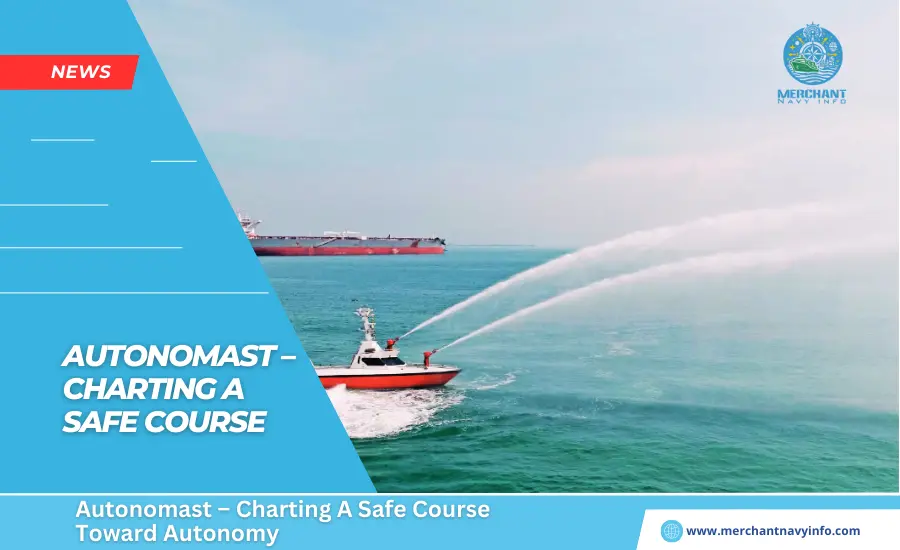
Autonomast are changing fast. In today’s complex geopolitical world, Unmanned Surface Vehicles (USVs) autonomasts have become an asset of choice for navies and maritime authorities worldwide. Easier to deploy than crewed vessels. Also, they are ideal for missions that can be carried out autonomously and/or that keep humans out of harm’s way. Yet the USV market is in constant evolution. The reason is the regulatory framework around autonomy. Thus potentially deterring some national authorities from integrating these systems into their fleet.
In such a context, autonomast is improving. Thus, flexibility is crucial. That is why ST Engineering – is a global technology, engineering, and defence group. They have developed the AUTONOMAST™, a modular kit that converts crewed vessels into Unmanned Surface Vessels (USV). The AUTONOMAST™ provides navies and maritime agencies the flexibility to move to unmanned at their own pace. Also, where it is most adequate, and without having to immediately commit time and resources to acquiring unmanned vessels.
Moving to autonomast
Over the past few years, geopolitical tensions have been growing in multiple regions around the world. For several navies, this has translated into increasing pressure on the finite amount of resources at their disposal. Including things like funds, capabilities and crew. Similarly, where local maritime authorities could provide critical support. Including Exclusive Economic Zone (EEZ) patrolling and protection – the growing number of threats to maritime security in these zones. Thus, it is stretching those resources thin.
To address these issues, several countries have started integrating unmanned systems into their fleet. From Mine Countermeasures (MCM) missions, which are increasing as mine warfare makes a comeback. Also, to patrolling and Search and Rescue (SAR) missions. Furthermore, the trend is toward replacing humans where it makes the most sense: in dull, dirty, and dangerous missions.
In fact, the global USV market is projected to expand at 10.6% between 2022 and 2030. This is according to a Research and Markets report on the Global USV market published in February 2024. Currently, the biggest USV market is the US (US$196.6 Million in 2022). However, a number of other countries have significant CAGR for the period between 2022 and 2030. It includes 9.8% for China, 9.6% for Japan and 8.7% for Canada.
Not good for every navy.
However, getting hands-on unmanned systems from scratch may not be suitable for every navy and maritime agency across the globe. In some countries, the cost of acquiring technologies from a still-maturing market is high. That is both technologically and in terms of regulatory framework. These may be initially too high, whether in terms of acquisition or setting up production facilities.
Jin Kiat Chua, Head of International Business for the Defence and Public Security cluster, adds, “The AUTONOMAST™ builds on our experience. Also, innovation-led approach to developing capabilities for the Singapore military over the past 50 years. With a small population and declining birth rate, there are fewer recruits for Singapore’s conscript armed forces. Here innovation in the USV space is but a key necessity. And this is one of the several innovations across the respective domains that we are now taking to the international market.”
Upgrades in the UAV market
For autonomasts, to date, the system has been successfully integrated into several ships in different countries. These include small vessels (15m) all the way to Ro-Ro ships. The whole integration process takes between 6 and 12 months, depending on complexity and compatibility.
Featuring fused radar and panoramic vision, the system provides the USV with 360° situational awareness. Thus, making it capable of detecting objects as small as a buoy. This is crucial not only to carry out missions requiring detection, identification, and tracking. Also, EEZ patrolling against illegal activities. However, it also ensures safe navigation in any environment.
Additionally, mesh Wi-Fi, LTE, and satellite communications allow secure connections between the operator control station and the USV. Combined with pan-tilt-zoom optics. Thus, allows operators to control the lens remotely and a powerful searchlight. Furthermore, the AUTONOMAST™ provides not only excellent situational awareness but also positive control authority over the vessel. Such features greatly facilitate missions such as patrolling and interdiction.
Today, the AUTONOMAST™ is the first system of its kind to be operationally proven. It has been successfully deployed in the Singapore Straits, with over 10,000 hours of operations in one of the busiest maritime environments in Asia. ST Engineering has also supported some of the most advanced USV developments globally, with proven successes in coastguard, maritime security, and MCM operations.
Autonomast™ Allows Room for Growth.
From a software point of view, the past 15 years of development have brought significant enhancements to the system as ST Engineering continues to integrate the latest technological innovations. Case in point, today, the AUTONOMAST™ features Artificial Intelligence (AI) software to enable smart navigation as well as a state-of-the-art obstacle detection software that facilitates obstacle avoidance and mission planning. With time, software evolutions have offered more room for operators to focus on mission-related objectives, reducing mundane tasks.
Similarly, because this is a factory-assembled solution that is calibrated and designed for easy on-site installation, it provides ST Engineering teams the flexibility to work closely with its customers to provide a system best suited to their needs. From the first meeting all the way to delivery, ongoing discussions provide the basis to understand where the AUTONOMAST™ might need adapting to better suit specific mission profiles.
And if/when customers feel ready to move on to acquiring whole USV solutions, ST Engineering can work with them to deliver its latest Venus-10 USV. Venus is a modular solution that can be easily deployed anytime, anywhere. It can be transported by air or sea in a 40–ft ISO container.
Ultimately, the aim is to chart the easiest course toward autonomast integration within a fleet.










